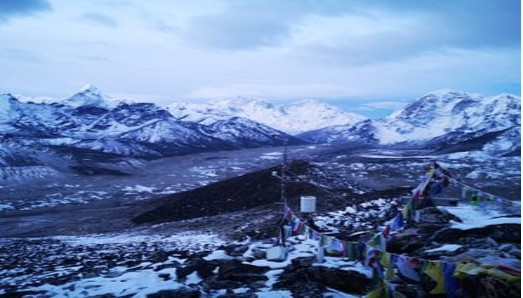Island Peak Climbing (Imja Tse) stands as one of Nepal’s most iconic trekking peaks, offering adventure seekers a perfect blend of challenge and accessibility. At 6,189 meters (20,305 feet), this magnificent mountain serves as an ideal training ground for those aspiring to climb higher Himalayan giants while providing experienced mountaineers with a rewarding expedition in its own right.
The Geography and History of Island Peak
Named “Island Peak” by Eric Shipton’s 1953 Everest expedition team due to its appearance as an island in a sea of ice when viewed from Dingboche, Imja Tse became an official climbing peak in 1983. The mountain sits in the heart of the Khumbu region, surrounded by some of the world’s highest peaks including Lhotse (8,516m), Nuptse (7,861m), and the imposing south face of Lhotse Shar.
The first successful ascent of Island Peak was accomplished in 1953 by Tenzing Norgay, Charles Evans, Alfred Gregory, and Charles Wylie as part of the training climb for the historic Everest expedition. Since then, it has become one of Nepal’s most climbed peaks, offering spectacular views of the Everest massif and surrounding Himalayan giants.
Best Time to Climb Island Peak
The climbing seasons for Island Peak generally align with Nepal’s trekking seasons:
- Pre-monsoon (Spring: March to May): Offers stable weather, warmer temperatures, and spectacular rhododendron blooms in the lower valleys. May can become increasingly humid as the monsoon approaches.
- Post-monsoon (Autumn: September to November): Features crystal-clear skies, excellent visibility, and stable weather conditions. October is particularly popular due to ideal climbing conditions.
- Winter (December to February): Possible but challenging due to extreme cold and potential heavy snowfall at higher elevations. Recommended only for experienced winter climbers.
- Monsoon (June to August): Generally avoided due to heavy rainfall, poor visibility, and increased risk of avalanches and landslides.
Required Permits and Regulations
To climb Island Peak legally, you’ll need:
- Island Peak Climbing Permit: Issued by the Nepal Mountaineering Association (NMA)
- Spring season (March-May): $250 per person
- Autumn season (September-November): $250 per person
- Winter/Summer seasons: $125 per person
- Sagarmatha National Park Entry Permit: Approximately $30 per person
- Khumbu Pasang Lhamu Rural Municipality Entrance Fee: Approximately $20 per person
- TIMS Card (Trekkers’ Information Management System): No longer required for the Everest region as of 2023
All climbers must be accompanied by a licensed Nepali climbing guide, and expeditions must follow environmental regulations regarding waste management and conservation.
Physical Preparation and Training
Island Peak requires significant physical preparation:
- Cardiovascular Endurance: Regular aerobic exercises like hiking, running, cycling, or swimming for at least 45-60 minutes, 4-5 times weekly, for 3-6 months before the climb.
- Strength Training: Focus on core, legs, and upper body strength with exercises like squats, lunges, step-ups, and pull-ups.
- Altitude Acclimatization: Prior experience at altitudes above 4,500m is highly recommended. The trek to Island Peak base camp serves as partial acclimatization.
- Technical Skills: Familiarity with basic mountaineering techniques including cramponing, ice axe use, rope management, and jumaring is essential.
- Mental Preparation: Develop mental resilience for challenging sections, cold temperatures, and altitude effects.
A minimum of 3-4 months of dedicated training is recommended before attempting Island Peak.
Essential Gear and Equipment
Climbing Equipment:
- Mountaineering boots (insulated, crampon-compatible)
- Crampons
- Ice axe
- Climbing harness
- Jumar (ascender)
- Carabiners (locking and non-locking)
- Figure 8 or belay device
- Prussik cords
- Climbing helmet
- Climbing slings/webbing
Clothing:
- Down jacket (800+ fill)
- Insulated mountaineering pants
- Hardshell jacket and pants
- Midlayers (fleece or down)
- Base layers (moisture-wicking)
- Mountaineering gloves (insulated)
- Liner gloves
- Warm hat/balaclava
- Sun hat
- Buff/neck gaiter
Personal Equipment:
- Expedition-quality sleeping bag (-20°C/-4°F rating)
- Sleeping pad
- Headlamp with spare batteries
- Trekking poles
- Glacier sunglasses (category 4)
- Goggles (for windy conditions)
- High SPF sunscreen and lip protection
- Backpack (50-60L)
- Water bottles/insulated thermos
- Personal first aid kit
- Water purification system
Most expeditions provide group equipment like tents, cooking gear, and climbing ropes.
The Route: From Lukla to Summit
Standard Itinerary (16-18 days):
Days 1-2: Kathmandu to Lukla and trek to Phakding (2,610m)
- Fly from Kathmandu to Lukla (2,840m)
- Trek to Phakding (3-4 hours)
Days 3-4: Phakding to Namche Bazaar (3,440m)
- 5-6 hour trek with significant elevation gain
- Acclimatization day in Namche with day hikes
Days 5-6: Namche to Tengboche (3,870m) to Dingboche (4,410m)
- Visit Tengboche Monastery
- Gradual ascent to Dingboche
Days 7-8: Dingboche to Chhukung (4,730m)
- Acclimatization day with possible climb of Chhukung Ri (5,550m)
Days 9-10: Chhukung to Island Peak Base Camp (5,200m)
- Trek to Base Camp
- Rest and preparation day with technical training
Day 11: Base Camp to High Camp (5,600m)
- Short but steep climb to High Camp
- Early dinner and rest before summit push
Day 12: Summit Day
- Start around 1-2 AM
- Technical climbing including glacier crossing, fixed ropes on headwall
- 45-degree snow and ice climb to summit ridge
- Summit and return to Base Camp (10-12 hours total)
Days 13-16: Descent to Lukla via Dingboche, Tengboche, and Namche
Day 17: Fly Lukla to Kathmandu
Technical Challenges on the Route
The Island Peak climb involves several technical sections:
- Glacier Crossing: Navigating the Imja Glacier requires crampons and rope team techniques to avoid crevasses.
- Headwall: The steepest section (approximately 100 meters) with slopes between 45-55 degrees requires using fixed ropes and jumaring skills.
- Summit Ridge: A narrow, exposed ridge requiring careful balance and concentration before reaching the summit.
- Altitude: The effects of high altitude present significant challenges, with potential for altitude sickness above 5,000m.
Guided vs. Independent Climbing
Island Peak regulations require climbers to be accompanied by licensed Nepali guides. Options include:
- Full-service Expedition: Provides all logistics, equipment, guides, porters, meals, and accommodation. Ideal for less experienced climbers. Cost: $2,800-$4,000.
- Budget Guided Option: Basic guiding services with shared equipment and more personal responsibility. Cost: $2,000-$2,800.
Independent climbing (without guides) is not permitted on Island Peak.
Safety and Risk Management
Altitude Sickness:
- Follow acclimatization schedule strictly
- Climb high, sleep low principle
- Stay hydrated (3-4 liters daily)
- Recognize symptoms: headache, nausea, dizziness, fatigue
- Descend immediately if severe symptoms develop
Weather Hazards:
- Monitor forecasts closely
- Be prepared to delay summit attempt in poor conditions
- Understand signs of deteriorating weather
Avalanche and Crevasse Awareness:
- Receive proper training before the expedition
- Follow guide instructions regarding rope teams
- Carry appropriate safety equipment
Emergency Procedures:
- Comprehensive travel insurance including helicopter evacuation coverage
- Communication devices (satellite phone/messenger)
- Knowledge of nearest medical facilities
- Clear emergency protocols established before climb
Cultural Considerations and Etiquette
When climbing in the Khumbu region:
- Respect local Sherpa culture and Buddhist traditions
- Walk clockwise around religious monuments (stupas, mani walls)
- Ask permission before photographing locals
- Support local businesses and sustainable tourism practices
- Treat porters and staff with respect and appropriate compensation
- Practice “Leave No Trace” principles throughout the journey
Environmental Impact and Sustainable Climbing
Island Peak faces increasing environmental challenges due to its popularity. Responsible climbers:
- Pack out all waste (including human waste at higher camps)
- Use established campsites only
- Minimize use of single-use plastics
- Support organizations working on conservation in the region
- Consider carbon offset programs for flights
Conclusion
Island Peak offers adventurers the perfect introduction to Himalayan mountaineering. While challenging enough to require technical skills and physical preparation, it remains accessible to determined trekkers taking their first steps into alpine climbing. The journey through the iconic Everest region, encounters with Sherpa culture, and the personal achievement of standing atop this 6,000-meter peak create an unforgettable experience that often serves as a gateway to larger mountaineering goals.
With proper preparation, respect for the mountain environment, and a humble approach to the challenges of high-altitude climbing, Island Peak provides one of the most rewarding mountaineering experiences in Nepal—a perfect balance of accessibility and alpine adventure.

